Click on images to enlarge
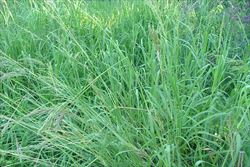
infestation (Photo: Sheldon Navie)
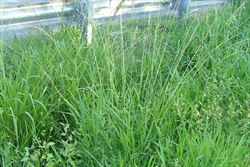
habit (Photo: Sheldon Navie)
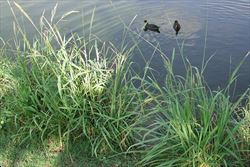
habit (Photo: Sheldon Navie)
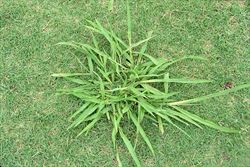
leaves (Photo: Sheldon Navie)
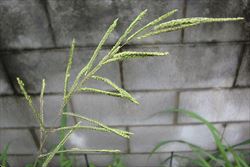
seed-head with numerous branches (Photo: Sheldon Navie)
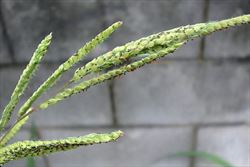
seed-head branches with numerous flower spikelets (Photo: Sheldon Navie)
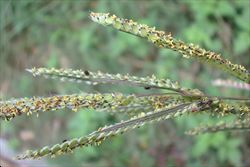
close-up of hairy flower spikelets (Photo: Sheldon Navie)
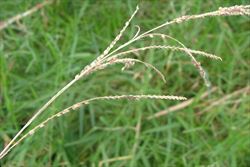
mature seed-head (Photo: Sheldon Navie)
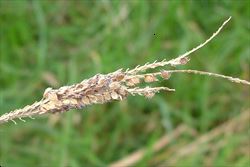
close-up of mature flower spikelets (Photo: Sheldon Navie)

close-up of seeds (Photo: Steve Hurst at USDA PLANTS Database)
Scientific Name
Paspalum urvillei Steud.
Family
Gramineae (South Australia)Poaceae (Queensland, New South Wales, the ACT, Victoria, Tasmania, Western Australia and the Northern Territory)
Common Names
giant paspalum, tall paspalum, upright paspalum, Vasey grass, vaseygrass, Vasey's grass
Origin
Native to South America (i.e. Bolivia, Brazil, Argentina, Chile, Paraguay and Uruguay).
Naturalised Distribution
A widely naturalised species that is most common in the south-eastern and eastern parts of Australia. It is common in eastern Queensland and eastern New South Wales. Also naturalised in Victoria, Tasmania, the coastal districts of south-western Western Australia and on Lord Howe Island.
Naturalised elsewhere, including in the USA, New Zealand, and on some Pacific islands (e.g. Western Samoa, New Caledonia and Hawaii).
Habitat
A weed of disturbed sites, footpaths, parks, gardens, roadsides, waste areas, wetlands, watercourses (i.e. riparian habitats), open woodlands, closed forests and pastures.
Habit
A large and long-lived grass forming dense tufts and usually growing 1-2.5 m tall.
Distinguishing Features
- a large and long-lived grass (1-2.5 m tall) usually forming dense tufts.
- its leaf blades (10-50 cm long and 3-15 mm wide) are narrowed at the base and mostly hairless.
- its seed-heads usually have 6-20 branches ranging from 5-15 cm long.
- its flower spikelets are arranged in pairs along the seed-head branches so that they appear to have four rows of seeds.
- these flower spikelets (2-3 mm long) are fringed with long silky hairs.
Stems and Leaves
The flowering stems (i.e. culms) are sometimes branched near the base and their joints (i.e. nodes) are usually hairless (i.e. glabrous).
The leaves consist of a sheath at the base, which encloses the stem, and a spreading leaf blade. The sheaths of lower leaves are sparsely or moderately hairy while the sheaths of upper leaves are sparsely hairy or hairless (i.e. glabrous). The leaf blades (10-50 cm long and 3-15 mm wide) are long and narrow (i.e. linear) with entire margins and pointed tips (i.e. acute apices). They are mostly hairless (i.e. glabrous), except for some long hairs near their narrowed bases. Where the leaf sheaths meet the leaf blade there is a small membranous structure (i.e. membranous ligule) up to 6 mm long.
Flowers and Fruit
The seed-heads (10-40 cm long) are born at the tops of the flowering stems (i.e. culms) and are made up of 6-20 spike-like branches (i.e. racemes). These branches (5-15 cm long) bear numerous flower spikelets and usually become progressively shorter towards the top of the seed-head. The small flower spikelets (2-3 mm long) are arranged in pairs so that the branches appear to have four rows of seeds. These flower spikelets are fringed with long silky hairs and consist of a pair of bracts (i.e. glumes) and two tiny flowers (i.e. florets), only one of which produces a seed. Flowering occurs mainly during summer.
The seeds (i.e. caryopses or grains) are oval (i.e. elliptic) in shape and 2-3 mm long. They are shed still contained within the remains of the flower spikelets.
Reproduction and Dispersal
This species reproduces mainly by seed, which are dispersed by wind, water, animals, vehicles, machinery, and in contaminated soil and agricultural produce.
Environmental Impact
Vasey grass (Paspalum urvillei) is regarded as an environmental weed in New South Wales and Western Australia.
Legislation
Not declared or considered noxious by any state government authorities.
Similar Species
Vasey grass (Paspalum urvillei) is similar to other closely-related grasses, including tussock paspalum (Paspalum quadrifarium), broad-leaved paspalum (Paspalum mandiocanum), paspalum (Paspalum dilatatum), Bahia grass (Paspalum notatum) and scrobic (Paspalum scrobiculatum). These species can be distinguished by the following differences:
- Vasey grass (Paspalum urvillei) is a tall grass (1-2.5 m tall) with relatively narrow leaves (4-9 mm across). It has relatively small flower spikelets (2-3 mm long) with long silky hairs on their margins and its seed-heads usually have 10-20 branches (i.e. racemes).
- tussock paspalum (Paspalum quadrifarium) is a tall grass (1-2 m tall) with relatively narrow leaves (4-9 mm across). Its relatively small flower spikelets (2-3 mm long) do not have long silky hairs on their margins and its seed-heads usually have 15-25 branches (i.e. racemes).
- broad-leaved paspalum (Paspalum mandiocanum) is a low-growing grass (less than 1 m tall) with relatively broad leaves (up to 20 mm across). Its relatively small flower spikelets (2-2.5 mm long) do not have long silky hairs on their margins and its seed-heads usually have only 3-10 branches (i.e. racemes).
- paspalum (Paspalum dilatatum) is a moderately-sized grass (usually about 1 m tall) with relatively narrow leaves (up to 12 mm across). It has relatively large flower spikelets (3-4 mm long) with long silky hairs on their margins and its seed-heads usually only have 3-7 branches (i.e. racemes).
- Bahia grass (Paspalum notatum) is a low-growing grass (usually less than 60 cm tall) with relatively narrow leaves (up to 10 mm across). Its relatively large flower spikelets (2.75-4 mm long) do not have long silky hairs on their margins and its seed-heads usually have only two branches (i.e. racemes).
- scrobic (Paspalum scrobiculatum) is a moderate-sized grass (usually 0.5-1.5 m tall) with relatively narrow leaves (3-12 mm across). Its relatively small flower spikelets (2-2.5 mm long) do not have long silky hairs on their margins and its seed-heads usually have only 2-7 branches (i.e. racemes).

